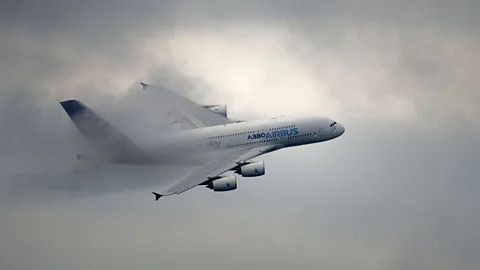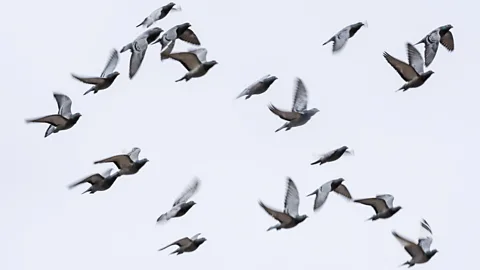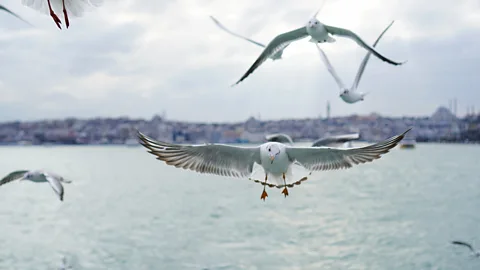Aircraft turbulence is worsening with climate change. Studying birds could help
 Getty Images
Getty ImagesOur skies are getting bumpier, making the need to understand and predict turbulence increasingly urgent. Researchers propose birds could provide clues.
When you look up, the sky may seem calm – still even – but air is always on the move. Fluid, it flows like water, with eddies and currents, sometimes smooth and serene, sometimes tumultuous and violent. Turbulence is one of the most unpredictable of all weather phenomena. And research shows that severe turbulence is becoming more likely as the planet warms.
If an aircraft strikes it, the most turbulent air can cause injuries or even death, as well as structural damage to planes. On Tuesday, a Singapore Airlines flight from London encountered severe turbulence: 31 people were injured, and one died. Passengers aboard the Boeing 777-300ER told the BBC the plane began to tilt and shake, before dropping suddenly, and "people and objects were thrown around the cabin".
Could there be better ways to predict and cope with turbulence? Some researchers believe that answers lie in the animal world.
Birds often encounter choppy skies. While only a few species reach the height of a cruising commercial aircraft, studying how they respond at lower altitudes could help meteorologists build better models to predict turbulence, says Emily Shepard, an expert in bird flight and air flow at Swansea University in Wales. And that's not all we could learn from our avian friends: some species have adapted to deal with "extreme turbulence", she says. Analysing how they exploit it to their advantage could inform aircraft design, especially in urban environments where smaller aircraft and unmanned aerial vehicles (UAVs) could fly.
 Getty Images
Getty ImagesAccording to a 2024 study, aircrafts encounter moderate to "severe-or-greater" turbulence 68,000 times every year. Turbulence is defined as "an irregular motion of the air" caused by eddies and vertical currents, and is associated with weather events such as fronts, wind shear and thunderstorms. Turbulence can cause a few uncomfortable bumps – or throw an aircraft out of control, inducing "chaotic rolls, pitches and yaws".
Modern aircraft are equipped with sophisticated weather radar systems that pilots use to identify and navigate around areas of turbulence. "We can successfully predict around 75% of turbulence up to 18 hours ahead," says Paul Williams, an atmospheric scientist at the University of Reading.
However, there are many types of turbulence – and some can be harder to spot. The severe turbulence that struck the Singapore Airlines flight is often caused by invisible "clear air turbulence". This can strike without warning, and is one of the biggest causes of weather-related aviation accidents.
Clear air turbulence occurs at high altitudes, where aircraft cruise in seemingly calm blue skies. It can't be seen by the naked eye and is undetectable by onboard sensors. Even satellites can't see this kind of turbulence, only the structure and shape of the jet stream which may hint at its presence. Pilots often have to rely on any aircraft flying the same path ahead of them of them to report clear air turbulence, so they can adjust their path.
Climate change is making clear air turbulence more common, says Williams, who has studied the rise. "In simple terms, climate change is increasing the temperature difference between the warm and cold air masses that collide to form the jet stream in the upper atmosphere," he says. "This effect is making the jet stream less stable and allowing more turbulence to break out."
 Getty Images
Getty ImagesMeteorologists are now seeking to develop better methods of forecasting all types of turbulence, using computer modelling. However, one source of data that's gone untapped until recently are the creatures we share the skies with: birds.
Previous studies have shown that animal movements can help us determine the strength of thermal updrafts, wind direction and wind speed.
Now researchers from Swansea University say birds' experience of the winds could help provide predictions of turbulence. Birds often migrate for thousands of miles – with wind speed, direction and turbulence all dictating the route they travel and the amount of energy they have to expend. And when you're running on reserves at the end of an epic trip half way around the world, catching the wrong winds can mean the difference between life and death.
While most species don't fly alongside cruising commercial jets, some get extremely high. Take frigate birds, for example. Their flight is a "roller-coaster", says Shepard. They rely on thermals and wind to stay aloft for months one end and can fly at extreme altitudes, as high as 13,000ft (4km/2.5 miles) above the ground. To reach this great height, they often catch strong updrafts in mountainous cumulus clouds.
"They gain altitude within these really, really turbulent cloud systems," says Shepard. "You get monstrous updrafts and downdrafts. They are operating in incredibly turbulent environments – and we know so little about how they are able to maintain flight control."
By studying how such birds respond to turbulence, Shepard and her colleaues at Swansea University's Laboratory for Animal Movement aim to "visualise the invisible", and to map what the air is doing.
Sometimes that even involves flying alongside the birds. From 2018 to 2019, Shepard's team flew an ultralight aircraft alongside a flock of homing pigeons. Using GPS, barometric pressure and acceleration data loggers attached to the birds – over 88 flights – they measured the turbulence levels during the journeys the birds took to return to their lofts.
"You're pretty exposed up there," says Shepard. "You're open to the elements. It's a very direct experience." The team flew in a variety of conditions; early morning when there was little ground heat to cause bumpy convective currents, later in the day when the thermals were stronger, and at different times of year.
"There were several occasions when the pilot was forced to land or decided he wasn't going to fly again that morning, because the turbulence was so strong and it was affecting his ability to maintain flight control. It was too bumpy for him," says Shepard. "But the pigeons returned to the loft with no problem. So, pigeons can deal with high levels of turbulence – more so than the ultralight. They clearly have mechanisms of coping with this turbulence."
 Getty Images
Getty ImagesThe Swansea University research suggests the possibility of using bird-borne sensors to shed light on air turbulence, much like the seal-borne sensors used to measure salinity and sea temperature.
"People are already equipping animals with tags for lots of different reasons and in lots of different environments," says Shepard. "They're effectively sampling in the environment all the time."
Birds could act as meteorological sensors on the move, she says, continuously collecting data about the turbulence they're experiencing along their flight paths. This, she adds, would be cheaper than using sensors fitted to aircraft, plus birds can fly in conditions that planes can't.
In another 2020 study, Shepard and her colleagues followed the flight of Andean condors, the world's heaviest soaring birds. They documented when and how individuals gained altitude, and recorded each and every wingbeat.
The data revealed the lowest levels of flapping flight recorded for any free-ranging bird, with the condors spending an incredible 99% of all flight time in glide-mode – without flapping at all. One bird even remained airborne for more than five hours – covering over 170km (100 miles) – without a single flap. This research provides insight into the way soaring birds exploit thermals, knowledge which could potentially feed into the programming of autonomous flying vehicles.
Investigations into how gulls soar above buildings could also help when it comes to planning flight paths for UAVs and drones in urban landscapes, says Shepard. In a similar way to birds, wind gusts and turbulence affect UAVs far more than larger aircraft, making flying at low altitudes in close proximity to terrain and buildings challenging.
"Urban environments are very turbulent. You've got all of these obstacles which disturb the flow. So, it's an ongoing challenge, thinking about how you can operate safely, particularly close to buildings where there's a risk that gusts could blow an aircraft towards a building and cause a crash."
Urbanisation too, says Shepard, is contributing to more turbulent skies. "We are modifying the substrate dramatically – and that is affecting the aerial environment above. Yet, we haven't really thought about urbanisation in terms of how it affects the costs and the abilities of animals to fly through that."
"There are still so many questions about turbulence," says Shepard – but one thing is for sure, our airborne travels across the globe are set to become rougher. Perhaps birds can teach us a thing or two about how to master the skies.
—
For essential climate news and hopeful developments to your inbox, sign up to the Future Earth newsletter, while The Essential List delivers a handpicked selection of features and insights twice a week.
